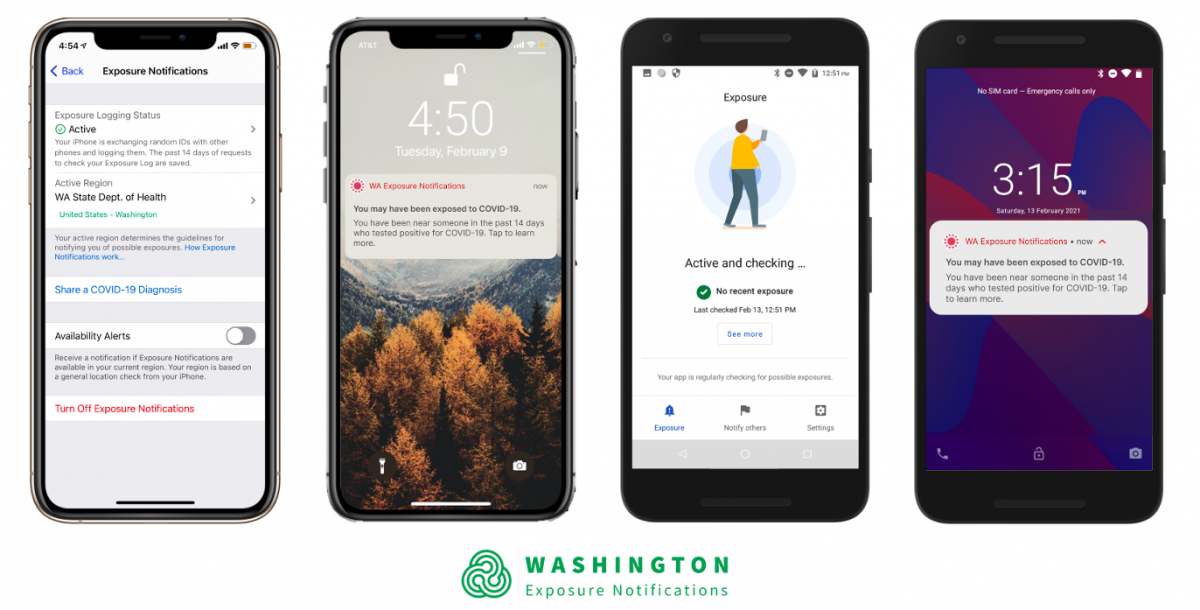Leah Pistorius
May 11, 2021
In HCDE's course on usability studies, a student team led a study of Washington State residents to understand reactions to and experiences with the Washington State Exposure Notifications Tool.

The students created web-based prototypes in Figma so they could conduct a remote study of people using the Washington State Exposure Notification tool.
In HCDE's graduate-level course on usability studies, students focus on usability testing and usability research as a user-centered design strategy. Students learn how to define an audience and issues, design and administer a usability study, analyze the results, and report the findings. Industry sponsors regularly propose projects for the study, and they receive a report of findings at the end of the quarter.
In the Winter 2021 usability studies course, led by Assistant Teaching Professor Sarah Coppola, HCDE master's students Elisabeth Fonden, Jin Jeon, Dana Langseth, and Emily Stensland teamed up on a project sponsored by the Washington Department of Health to study the Washington State Exposure Notifications tool — also known as WA Notify.
WA Notify is a smartphone tool that alerts people if they may have been exposed to COVID-19. The tool works as an app on Android phones and within the systems menu on iPhones, using bluetooth technology. If a WA Notify user tests positive for COVID-19 and adds that information to the tool, other WA Notify users who have been nearby within the last two weeks will receive a notification that they have had a possible exposure to the virus.
"This project was really interesting to work on, because the exposure app seemed like it may have just been a public health effort, but it was a partnership between the Washington State Department of Health, the Clinical Informatics Research Group at UW, Apple, and Google," Langseth said. "I appreciated seeing these teams from very different fields come together to create an impactful system for everyday people. And, the fact that they came to us in HCDE to connect with actual users of the tool demonstrates a commitment to the human element of the platform."
As project sponsors, the WA Notify team asked the HCDE students to study a few features of the WA Notify tool. They were curious what users experience as differences between interactions on the iPhone and Android platforms, first reactions people have when installing the tool, and how people process the information provided on the web-based resources.
The students recruited 11 study participants of both iPhone and Android users from across Washington State. They built web-based prototypes and interviewed the study participants remotely.
"We created prototypes in Figma, which is a web-based prototyping platform. We designed both an Android lookalike and an iPhone lookalike, so our study participants basically saw a phone displayed on a web browser," described Stensland. "We had them go through a series of tasks we pre-defined, and we talked with them about initial reactions, feelings, and pain points they experienced as they navigated through the tool."
To reduce a bias toward one of the two operating systems, the students had half the study participants begin the tasks on the iPhone, half start on Android, and then switch. "One thing that surprised us was that one of our initial goals was to figure out differences between the tool on iPhone and Android, and which one users liked better," Fonden said. "Our study results were basically split down the middle as far as that question went. We expected one to be more popular, but we definitely found biases based on which type of phone people already had."
The students did pinpoint several opportunities for simplifying information presented in the tool and the web-based resources. In a final presentation to the WA Notify sponsors, the students recommended that the tool clarifies terminology that can come across as jargon, highlights a clear call to action when someone is exposed, and reorganizes areas of dense text on the website.
A key recommendation the students made was to incorporate more sensitivity in the notification message that alerts someone they may have been exposed. "We found that users experience feelings of panic when they receive an exposure notification, and the instructions of what to do next were difficult to understand and are not very personal," Jeon said. "So we recommended making that information more empathetic and clear."
The WA Notify sponsors had already been considering how the exposure notification messages were perceived, and they took the students' suggestions to heart. "Not long after our presentation, the sponsors let us know they were already making some updates to the exposure notification message, and they asked us for our feedback to see if that was in line with what we had seen in our study," Langseth said.
"It feels good to be able to provide the sponsor with evidence-based solutions — that's really the value that HCDE brings to these organizations," Fonden said. "By talking to the people who are using this tool we are able to save the sponsor money in the long term. And hopefully, we are contributing to making the product more beneficial for the people it's designed for."
"Instead of being seen as a one-way thing, where the government is communicating with the individual, we brought our experience as HCDE researchers to prioritize the emotions and feelings of the actual communities who are using this tool," Jeon said. "Incorporating feedback directly from the users helps make this more of a two-way system that benefits everyone."
Do you have a product or service that could benefit from a usability analysis? HCDE welcomes project proposals from industry and academic partners. If your project is accepted, students will formulate an appropriate usability study, design and execute that study, and analyze and report on their findings. Learn more »